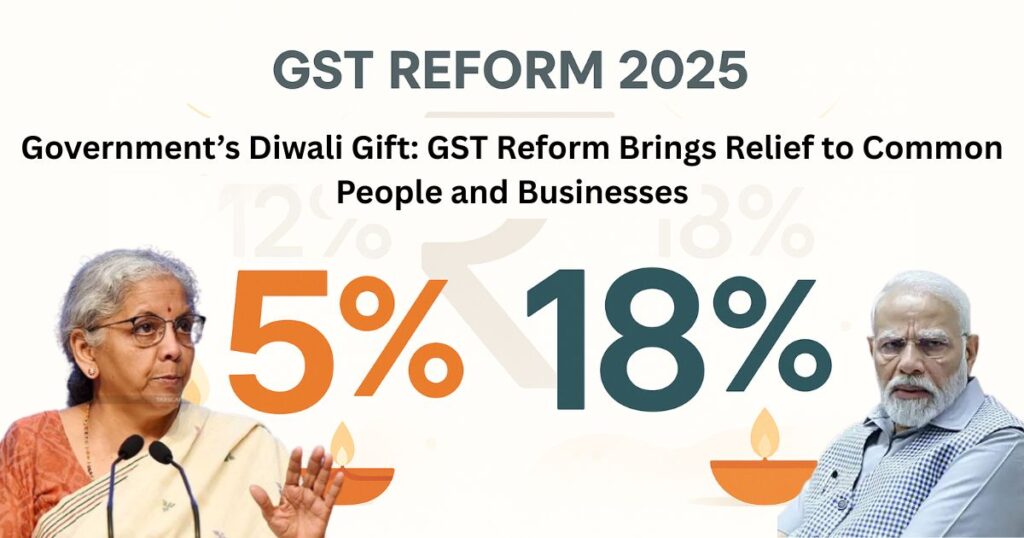The Indian government has announced a major overhaul of the Goods and Services Tax (GST) system, dubbed a Diwali gift by Prime Minister Narendra Modi. This reform proposes eliminating the current 12% and 28% tax slabs, retaining only the 5% and 18% slabs. Under this plan, about 99% of items in the 12% slab will move to 5%, and approximately 90% of items in the 28% slab will shift to 18%. Certain items, such as gold, alcohol, or luxury products, may attract special tax rates.

This change is expected to be finalized in the GST Council meeting scheduled for September or October 2025. The goal is to simplify the tax system, make daily essentials more affordable, and provide relief to small businesses. This article breaks down every aspect of the reform in simple language to help you understand its impact on you.
Why Were 5% and 18% Tax Slabs Chosen?
The government selected the 5% and 18% tax slabs because they are the most balanced for both consumers and businesses. The 5% slab includes essential items like food (flour, oil, pulses), affordable clothing, and medicines, ensuring relief for the poor and middle class. The 18% slab covers mid-range items like electronics (fans, TVs), furniture, and services, which form a significant part of the economy.
Eliminating the 12% and 28% slabs will:
- Simplify the tax system, making it easier for consumers and businesses to understand.
- Encourage spending by reducing tax rates, boosting market demand.
- Ensure stability in tax collection with minimal impact on government revenue.
Example: A fan priced at ₹1,000, previously taxed at 12% (₹1,120 total), will now fall under 5% (₹1,050 total), saving you ₹70.
History and Current Status of GST in India
The concept of GST was introduced in 2000 under the Atal Bihari Vajpayee government to create a unified tax system. Before 2017, India had multiple taxes like VAT, service tax, and excise duty, which complicated business operations.
When GST was implemented in 2017, it introduced four main tax slabs:
- 5%: Essential items (food, medicines)
- 12%: Mid-range items (clothing, small electronics)
- 18%: General-use items (furniture, services)
- 28%: Luxury and expensive items (TVs, cars)
Over the years, GST has seen several revisions, including rate reductions and special rates for certain items. Now, the government aims to simplify it further by retaining only the 5% and 18% slabs.
What Will Change Technically?
The GST reform will bring the following changes:
- 12% and 28% slabs will be removed, with most items shifting to 5% or 18%.
- Special tax rates will apply to items like gold (3%), health insurance, and agricultural products.
- Tax processes will be streamlined, with faster returns and refunds.
This will reduce paperwork for small businesses and make products more affordable for consumers. For instance, a ₹10,000 TV previously taxed at 28% will now fall under 18%, saving ₹800-1,000.
Which Items Will Have Special Tax Rates?
Certain items will have tax rates different from 5% or 18%, based on social and economic needs:
- Luxury items: Expensive cars, jewelry, designer clothing.
- Alcohol and tobacco: Subject to state taxes, not GST.
- Gold and silver: Likely to retain 3% tax.
- Health and life insurance: Lower taxes or exemptions.
- Agricultural products: Fertilizers, seeds, and equipment may get tax relief.
- Eco-friendly items: Solar panels, organic products.
These rates ensure essential items remain affordable while taxing luxury goods appropriately.
Impact on Common Households
The GST reform will make daily essentials more affordable, benefiting middle and lower-middle-class families. Examples:
- Clothing: From 12% to 5%, reducing prices by up to 7%.
- Electronics: From 28% to 18%, saving up to 10%.
- Groceries: Items like oil and flour, already at 5% or less, will see no major change.
This will increase purchasing power, especially during the festive season, allowing families to save more.
Benefits for Small Businesses and MSMEs
Small businesses and MSMEs will gain significantly:
- Lower taxes: Cheaper products will boost sales.
- Simpler rules: Online registration and pre-filled returns will reduce paperwork.
- Faster refunds: More capital for business growth.
- Fewer errors: A simpler system means fewer mistakes.
This will help MSMEs earn higher profits and create more jobs.
ALSO READ- Complete Guide for Small Businesses on GST and UPI: Tax Rules, Digital Payments, and Risk Management
Challenges and Risks
Some challenges include:
- Revenue loss: The government may lose ₹50,000 crore annually.
- State budgets: Reduced revenue could affect state funding.
- Initial hiccups: Confusion may arise during the transition.
The government must address these to ensure minimal economic disruption.
Sector-Wise Impact
- FMCG: Food, soap, and toothpaste will become cheaper, boosting sales.
- Automobile: Small cars and bikes will be more affordable; luxury cars may face special taxes.
- Retail: Easier compliance and lower costs will increase sales.
- Luxury goods: Prices may remain stable due to special rates.
The festive season will see a surge in demand due to lower prices.
Implementation Process and Timeline
The GST reform is expected to roll out by Diwali 2025. The process includes:
- GST Council meeting in September 2025 to finalize changes.
- Adjusting tax rates and rules.
- Issuing legal notifications for implementation.
7 Essential Steps for Retailers and Manufacturers
- Update pricing: Adjust product prices based on new tax rates.
- Billing systems: Update software for 5% and 18% slabs.
- Invoices: Align tax invoices with new rules.
- Supplier coordination: Discuss new rates with suppliers.
- Staff training: Educate employees on GST changes.
- Customer communication: Inform customers about price changes.
- Tax compliance: Ensure timely filing of returns.
Market and Investor Reaction
The stock market has reacted positively to the GST reform announcement, with expectations of growth in FMCG and retail sectors. Retailers are preparing by revising pricing and launching festive season offers.
Expert and Government Opinions
Tax expert Krishna Arora says, “This GST reform is a game-changer for small businesses and consumers.” The Finance Ministry emphasizes that the reform will make the tax system transparent and business-friendly.
Press Information Bureau (PIB) -GST Structure Overview – a recent official press note describing the existing four-slab structure (5%, 12%, 18%, 28%) determined by the GST Council.
Will household items get cheaper?
Yes, removing 12% and 28% slabs will lower prices.
Which items will move from 28% to 18%?
Expensive electronics and some luxury goods.
What relief for MSMEs?
Lower taxes, simpler rules, and faster refunds.
How many GST slabs will remain?
Two main slabs (5%, 18%) and some special rates.
Conclusion
The GST reform will make India’s tax system simpler, more affordable, and transparent. It will benefit consumers with cheaper goods, help small businesses with easier rules, and boost the economy. While challenges like revenue loss and state budgets need attention, effective implementation could make this a historic step for India.
How will the GST reform impact your shopping or business? Share your thoughts in the comments below! Stay updated on the latest tax changes by subscribing to our newsletter and follow us on social media for more insights on Government related News.


